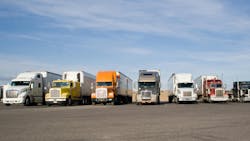Key takeaways:
- For a successful transition to alternative powertrains, cross-functional teams are key.
- Understanding operational duty cycles is essential for choosing the right powertrain options and infrastructure.
- External expertise can be attained by hiring consultants or engaging with customers and OEMs for valuable insight during the transition.
One of the things we learned from Run on Less – Electric Depot was that it isn’t really possible for a fleet to increase the number of battery-electric vehicles at a site without involving a host of other people in the process.
As we start learning more about the fleets that have agreed to participate in Run on Less – Messy Middle, I am starting to see the same thing. Choosing whether to venture into an alternative powertrain solution is a significant decision, even if you are just going to get your feet wet by adding one or two trucks. But it is critical if you plan to make a wholesale change.
What has become very clear to me and to the fleets that have already added powertrain solutions such as renewable diesel, natural gas, battery electric, or hydrogen fuel cell is that duty cycle matters. And it matters a lot.
Therefore, before considering an alternative powertrain solution, a fleet should have a thorough understanding of the intricacies of the duty cycles in which it operates. You also need someone who understands the ins and outs of each of the available powertrain options. And you need someone who has a good grasp on the fueling/charging infrastructure that you may need to add to your location or be able to access in the geographic locations in which you operate.
As you look at the viability of alternative powertrain solutions in your operations, I suggest you be aggressive about assembling a team to help you navigate the transition. You are going to need people with a wide range of skills. And you might not be able to find all those skills within your operation, but looking within is a good place to start. Involve people from across the organization, including those on the maintenance and repair side, finance, dispatch, drivers, facilities, and more. Ideally, you should assemble a cross-functional team because such groups bring diverse perspectives and new ideas to the table.
See also: Carriers across the industry join NACFE's 'Messy Middle' Run
Once you’ve selected people from within your organization who can be helpful in the transition, determine where you still have knowledge gaps. Do you need to hire an outside consultant who can bring a more unbiased vision to the process? Would input from a customer be of value to the team? Do you need to add someone who has expertise in change management? What about involving someone from your OEM?
Also, consider adding someone who is familiar with the fueling/charging challenges you will face. If you are a supplier or consultant, find the fleets you think you can help and offer your services. Be sure your offerings fit their unique needs and explain why you can help.
The phrase, “it takes a village,” may have been overused, but the sentiment is spot on. Transitioning to a cleaner freight future is complex, and there is no reason to try to navigate it alone when there are many people who are willing to help.
Not to put in a shameless plug, but I suspect you’ll learn a few things by following the fleets that have agreed to be in Run on Less – Messy Middle. We have site visits lined up for most fleets starting early in June and plan to publish fleet profiles, including routes and duty cycles, throughout August. During the Run, we will be gathering data on how the trucks are performing, and we will be sharing that with the industry.
I hope you’ll consider the Run and NACFE as part of your team. Our goal is to see that the entire trucking industry has as much information as possible as it navigates through the Messy Middle and works to move freight in a more sustainable manner.
About the Author

Michael Roeth
Executive Director
Michael Roeth is the executive director of the North American Council for Freight Efficiency. He serves on the second National Academy of Sciences Committee on Technologies and Approaches for Reducing the Fuel Consumption of Medium and Heavy-Duty Vehicles and has held various positions with Navistar and Behr/Cummins.
